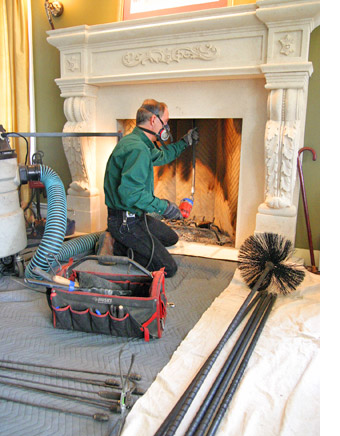The Ultimate Chimney Cleaning List for Homeowners
Guaranteeing the safety and efficiency of your chimney is a crucial responsibility for home owners who count on their fire place or timber cooktop for heat throughout the chillier months. A well-kept chimney not just improves the overall performance of your furnace but additionally reduces the danger of potential hazards such as fires and carbon monoxide gas leakages. With a detailed checklist in hand, home owners can systematically address crucial maintenance tasks that are essential for a safe and tidy chimney. From evaluating the smokeshaft structure to eliminating creosote build-up, each action plays an essential function in guarding your home and liked ones.
Smokeshaft Examination and Assessment
The interior of the chimney should be checked for any kind of blockages, such as bird nests or excess residue, which can position a fire risk. Examining the flue for creosote buildup is crucial as this extremely flammable substance can trigger a chimney and spark fire.

Outside Maintenance and Repair Works
Inspecting the outside of the smokeshaft for any type of structural concerns, such as fractures, loose blocks, or signs of water damages, is necessary in guaranteeing the overall safety and security and long life of the smokeshaft. Consistently inspecting for any splits in the mortar or bricks can help stop water from leaking in and creating damage to the smokeshaft structure. Resolving these exterior upkeep issues in a timely manner can lengthen the life of your chimney and stop costly repairs down the line.
Cleansing the Smokeshaft Flue and Damper
To make sure correct functioning and safety and security of your chimney, normal cleaning of the chimney flue and damper is essential. The smokeshaft flue is the passage that enables smoke and gases to leave your home, while the damper is a movable plate that manages air movement. Begin by checking the flue for any kind of blockages such as bird nests, particles, or creosote accumulation. Make use of a flashlight to inspect for any indicators of damage or obstructions. Next off, thoroughly get rid of any debris utilizing a smokeshaft brush or vacuum developed for this objective. Ensure that the damper opens and shuts efficiently, as a properly operating damper helps control air movement and prevents drafts when the chimney is not being used. In addition, consider setting up a smokeshaft cap to avoid debris and animals from going into the flue. Routine upkeep of the smokeshaft flue and damper not just boosts the efficiency check over here of your smokeshaft however additionally reduces the threat of smokeshaft fires and carbon monoxide buildup in your house.
Removing Creosote Accumulation Safely
How can property owners securely get rid of creosote buildup from their smokeshaft to maintain its optimum performance and security? Creosote, a result of shedding wood, can accumulate in chimneys gradually, posing a fire hazard otherwise correctly managed. To securely get rid of creosote buildup, start by making certain helpful site the smokeshaft is awesome and there are no remaining coal. Utilize a flashlight to evaluate the inside of the smokeshaft for creosote deposits.
There are different approaches to get rid of creosote, depending upon the buildup's intensity. For light creosote accumulation, using a chimney brush or a homemade creosote remover made of equal components water and vinegar can be efficient (Chimney Sweep San Jose). For thicker deposits, specialist chimney cleaning company might be needed
It's critical to use protective equipment such as handwear covers, goggles, and a mask when dealing with creosote to avoid skin irritation or breathing. In addition, proper ventilation while cleansing the chimney is important to avoid breathing in hazardous fumes. Normal chimney inspections and cleansings can assist avoid creosote accumulation, ensuring the safety and efficiency of your check my source chimney.
Fire Safety And Security Precautions for Smokeshaft Owners
Routine smokeshaft inspections by qualified professionals are vital to identify any type of clogs, creosote buildup, or architectural concerns that could present a fire threat. Setting up a smokeshaft cap can protect against debris, animals, and rain from entering the smokeshaft and causing blockages or damages. In addition, chimney owners ought to have a spark arrestor or chimney stimulate arrester mounted to prevent stimulates from running away and possibly firing up close-by combustibles.

Conclusion
By following the best smokeshaft cleaning list described in this article, home owners can check, clean, and fix their chimney effectively. Correct maintenance not just minimizes the risk of smokeshaft fires but additionally extends the lifespan of the chimney system.
Checking the smokeshaft cap and crown for any damages is vital to protect against water from leaking right into the chimney and creating further deterioration.
Normal maintenance of the smokeshaft flue and damper not just improves the performance of your smokeshaft but additionally minimizes the threat of smokeshaft fires and carbon monoxide build-up in your home.
Regular chimney examinations and cleanings can assist prevent creosote accumulation, making certain the safety and effectiveness of your smokeshaft. (Chimney Sweep San Jose)
Mounting a chimney cap can prevent debris, pets, and rain from getting in the smokeshaft and causing blockages or damage. Appropriate upkeep not just lowers the threat of smokeshaft fires but also prolongs the life expectancy of the chimney system.